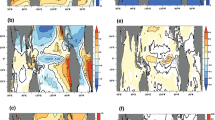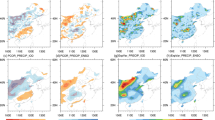Abstract
Lag correlations between sea surface temperature anomalies (SSTA) in the southeastern tropical Indian Ocean (STIO) in fall and Niño 3.4 SSTA in the eastern equatorial Pacific in the following fall are subjected to decadal variation, with positive correlations during some decades and negative correlations during others. Negative correlations are smaller and of shorter duration than positive correlations. Variations in lag correlations suggest that the use of the Indian Ocean Dipole (IOD) as a predictor of the El Niño-Southern Oscillation (ENSO) at a lead time of one year is not effective during some decades. In this study, lag correlations between IOD and ENSO anomalies were analyzed to investigate why the IOD-ENSO teleconnection disappears during decades with negative correlations. Anomalies induced by the IOD in the equatorial Pacific Ocean during decades with negative correlations are still present, but at a greater depth than in decades with positive correlations, resulting in a lack of response to oceanic channel dynamics in the cold tongue SSTA. Lag correlations between oceanic anomalies in the west Pacific warm pool in fall and the equatorial Pacific cold tongue with a one-year time lag are significantly positive during decades with negative correlations. These results suggest that oceanic channel dynamics are overwhelmed by ocean-atmosphere coupling over the equatorial Pacific Ocean during decades with negative correlations. Therefore, the Indonesian throughflow is not effective as a link between IOD signals and the equatorial Pacific ENSO.
Similar content being viewed by others
References
Abram N J, Gagan M K, Cole J E, Hantoro W S, Mudelsee M. 2008. Recent intensification of tropical climate variability in the Indian Ocean. Nat. Geosci., 1: 849–853.
Alexander M A, Bladé I, Newman M, Lanzante J R, Lau N C, Scot J D. 2002. The atmospheric bridge: the influence of ENSO teleconnections on air-sea interaction over the global oceans. J. Climate, 15: 2 205–2 231.
An S I, Hsieh W W, Jin F F. 2005. A nonlinear analysis of the ENSO cycle and its interdecadal changes. J. Climate, 18: 3 229–3 239
Annamalai H, Xie S P, McCreary J P, Murtugudde R. 2005. Impact of Indian Ocean sea surface temperature on developing El Niño. J. Climate, 18: 302–319.
Ashok K, Chan W L, Motoi T, Yamagata T. 2004. Decadal variability of the Indian Ocean Dipole. Geophys. Res. Lett., 31: L24207, http://dx.doi.org/10.1029/2004GL021345.
Behera S K, Luo J J, Masson S, Rao S A, Sakuma H, Yamagata T. 2006. A CGCM study on the interaction between IOD and ENSO. J. Climate, 19: 1 688–1 705.
Cai W J, Meyers G, Shi G. 2005. Transmission of ENSO signal to the Indian Ocean. Geophys. Res. Lett., 32: L05616, http://dx.doi.org/10.1029/2004GL021736.
Carton J A, Giese B S. 2008. A reanalysis of ocean climate using simple ocean data assimilation (SODA). Monthly Weather Review, 136: 2 999–3 017.
Chowdary J S, Xie S P, Tokinaga H, Okumura Y M, Kubota H, Johnson N C, Zheng X T. 2012. Interdecadal variations in ENSO teleconnection to the Indo-western Pacific for 1870–2007. J. Climate, 25: 1 722–1 744.
Dominiak S, Terray P. 2005. Improvement of ENSO prediction using a linear regression model with a southern Indian Ocean sea surface temperature predictor. Geophys. Res. Lett., 32: L18702, http://dx.doi.org/10.1029/2005GL023153.
Du Y, Xie S P, Hu K, Huang G. 2009. Role of air-sea interaction in the long persistence of El Niño-induced north Indian Ocean warming. J. Climate, 22: 2 023–2 038.
Gershunov A, Barnett T. 1998. Interdecadal modulation of ENSO teleconnection. Bull. Amer. Meteor. Soc., 79: 2 715–2 725.
Huang G, Hu K M, Xie S P. 2010. Strengthening of tropical Indian Ocean teleconnection to the northwest Pacific since the Mid-1970s: an atmospheric GCM study. J. Climate, 23: 5 294–5 304.
Izumo T, Legaigne M, Vialard J, Luo J J, Yamagata T, Madec G. 2013. Influence of the Indian Ocean Dipole and Pacific recharge on following year’s El Niño: interdecadal robustness. Clim. Dynam., http://dx.doi.org/10.1007/s00382-012-1628-1.
Izumo T, Vialard J, Lengaigne M, Clement de B M, Behera S K, Luo J J, Cravatte S, Masson S, Yamagata T. 2010. Influence of the Indian Ocean Dipole on following year’s El Niño. Nat. Geosci., 3: 168–172.
Kaplan A, Cane M, Kushnir Y et al. 1998. Analyses of global sea surface temperature 1856–1991. J. Geophy. Res., 103: 567–589.
Klein S A, Soden B J, Lau N C. 1999. Remote sea surface temperature variations during ENSO: evidence for a tropical atmospheric bridge. J. Climate, 12: 917–932.
Kug J S, Ham Y G. 2012. Indian Ocean feedback to the ENSO transition in a multi-model ensemble. J. Clim., 25: 6 942–6 957.
Lau N C, Nath M J. 2003. Atmosphere-ocean variations in the Indo-Pacific sector during ENSO episodes. J. Climate, 16: 3–20.
Leloup J A, Lachkar Z, Boulanger J P, Thiria S. 2007. Detecting decadal changes in ENSO using neural networks. Clim. Dyn., http://dx.doi.org/10.1007/s00382-006-0173-13.
Luo J J, Zhang R, Behera S, Masumoto Y, Jin F F, Lukas R, Yamagata T. 2010. Interaction between El Niño and extreme Indian Ocean Dipole. J. Climate, 23: 726–742.
Ohba M, Nohara D, Ueda H. 2010. Simulation of asymmetric ENSO transition in WCRP CMIP3 multi-model experiments. J. Climate, http://dx.doi.org/10.1175/2010JCLI3608.1.
Okumura Y M, Deser C. 2010. Asymmetry in the duration of El Niño and La Niña. J. Climate, 23: 5 826–5 843.
Rayner N A, Parker D E, Horton E B, Folland C K, Alexander L V, Rowell D P, Kent E C, Kaplan A. 2003. Global analyses of sea surface temperature, sea ice, and night marine air temperature since the late nineteenth century. J. Geophys. Res., 108: 4407, http://dx.doi.org/10.1029/2002JD002670.
Saji N H, Goswami B N, Vinayachandran P N, Yamagata T. 1999. A dipole mode in the tropical Indian Ocean. Nature, 401: 360–363.
Santoso A, England M H, Cai W. 2012. Impact of Indo-Pacific feedback interactions on ENSO dynamics diagnosed using ensemble climate simulations. J. Climate, 25: 7 743–7 763.
Smith T M, Reynolds R W, Peterson T C, Lawrimore J. 2008. Improvement to NOAA’s historical merged Land-Ocean surface temperature analysis (1880–2006). J. Clim ate, 21: 2 283–2 296.
Tao W C, Huang G, Hu K M, Qu X, Wen G H, Gong H N. 2014. Interdecadal modulation of ENSO teleconnections to the Indian Ocean Basin Mode and their relationship under global warming in CMIP5 models. International Journal of Climatology, http://dx.doi.org/10.1002/joc.3987.
Ummenhofer C C, Sen Gupta A, Li Y, Taschetto A S, England M H. 2011. Multi-decadal modulation of the El Niño-Indian monsoon relationship by Indian Ocean variability. Environ. Res. Lett., http://dx.doi.org/10.1088/1748-9326/6/3/034006.
Wang C, Picaut J. 2004. Understanding ENSO physics—a review. In: Wang C, Xie S-P, Carton J A eds. Earth’s climate: the oceanatmosphere interaction. AGU Geophysical Monograph Series. 147: 21–48.
Webster P J, Moore A M, Loschnigg J P, Leben R R. 1999. Coupled ocean-atmosphere dynamics in the Indian Ocean during 1997–1998. Nature, 401: 356–360.
Wu R, Kirtman B P. 2004. Understanding the impacts of the Indian Ocean on ENSO variability in a coupled GCM. J. Climate, 17: 4 019–4 031.
Xie S P, Du Y, Huang G, Zheng X T, Tokinaga H, Hu K M, Liu Q Y. 2010. Decadal shift in El Niño influences on Indo-Western Pacific and East Asian Climate in the 1970s. J. Climate, 23: 3 352–3 368.
Xie S P, Hu K, Hafner J, Tokinaga H, Du Y, Huang G, Sampe T. 2009. Indian Ocean capacitor effect on Indo-western Pacific climate during the summer following El Niño. J. Climate, 22: 730–747.
Yuan D L, Wang J, Xu T F, Xu P, Zhou H, Zhao X, Luan Y H, Zheng W P, Yu Y Q. 2011. Forcing of the Indian Ocean dipole on the interannual variations of the Tropical Pacific Ocean: Roles of the Indonesian throughflow. J. Climate, 15: 3 597–3 608.
Yuan D L, Zhou H, Zhao X. 2013. Interannual climate variability over the tropical Pacific Ocean induced by the Indian Ocean dipole through the Indonesian Throughflow. J. Climate, 26: 2 845–2 861.
Yuan Y, Li C Y. 2008. Decadal variability of the IOD-ENSO relationship. Chinese Science Bulletin, 53(11): 1 746–1 752.
Author information
Authors and Affiliations
Corresponding author
Additional information
Supported by the National Basic Research Program of China (973 Program) (Nos. 2012CB956000, 2011CB403502), the National Natural Science Foundation of China (No. 41176019), the China Meteorological Administration (No. GYHY201306018), and the Strategic Priority Program of Chinese Academy of Sciences (No. XDA11010301)
Rights and permissions
About this article
Cite this article
Xu, T., Yuan, D. Why does the IOD-ENSO teleconnection disappear in some decades?. Chin. J. Ocean. Limnol. 33, 534–544 (2015). https://doi.org/10.1007/s00343-015-4044-7
Received:
Accepted:
Published:
Issue Date:
DOI: https://doi.org/10.1007/s00343-015-4044-7




